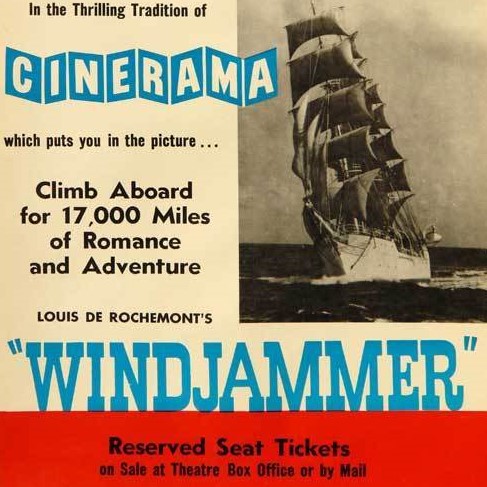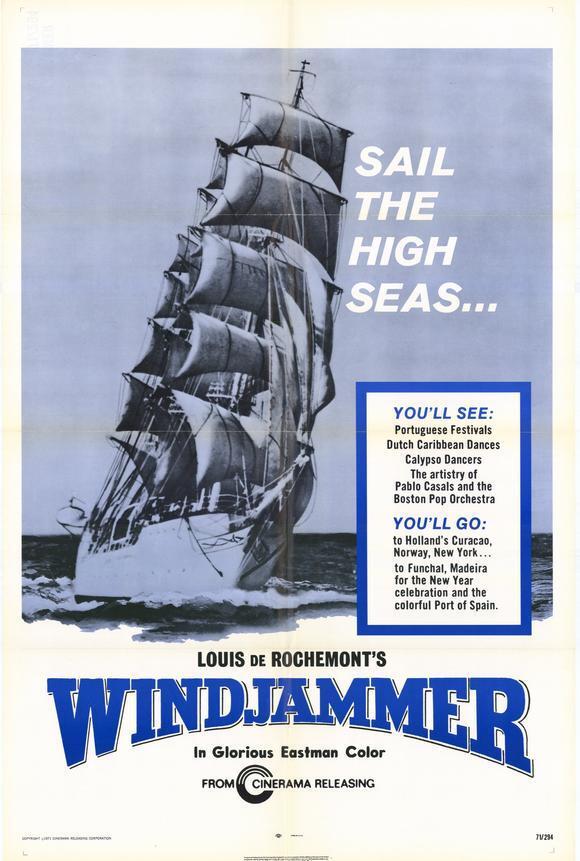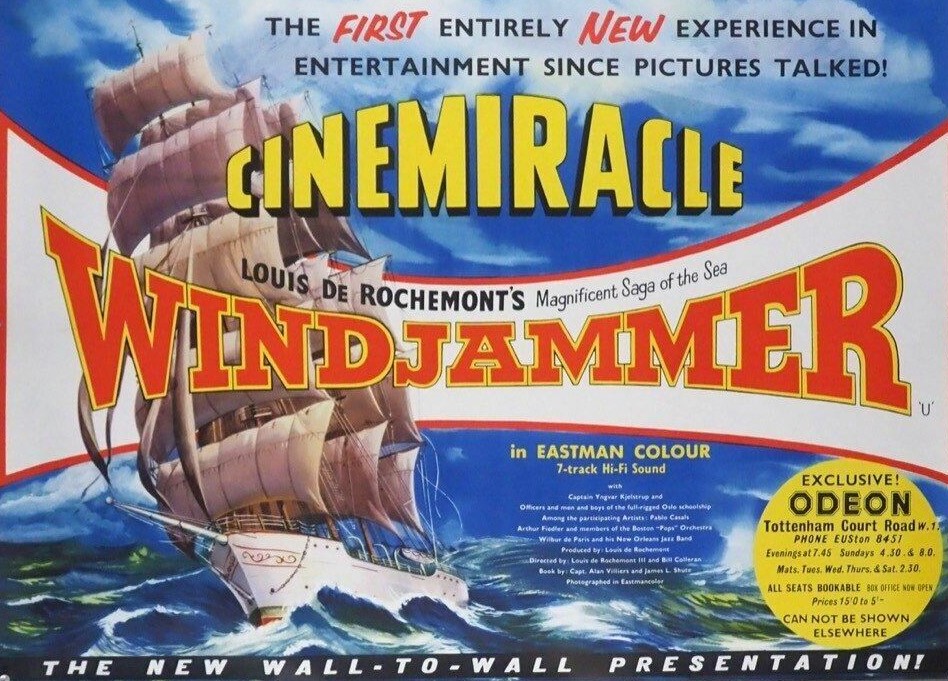It took this Norwegian interloper to show Cinerama the dramatic potential of its innovative widescreen process. A “windjammer” is a sailing ship and in this case training vessel Christian Radich embarking on a 239-day 17,000-mile round trip.
Although following primarily a documentary format, very close to the travelog style of Cinerama, the process that projected film on three synchronized 35mm projectors onto a curved 146-degree screen. It was much wider than the later Cinemascope and, like Imax, very much viewed as “event cinema,” the movies shown in roadshow to audiences astounded by the size of the images.

By the time Windjammer appeared, Cinerama had released six movies – This Is Cinerama (1952), Cinerama Holiday (1955), Seven Wonders of the World (1956), Search for Paradise (1957) and South Sea Adventure (1958). But the process was then mothballed as the producers worked out how to develop dramatic storylines. And, in some respects, you could argue, Windjammer showed them the way. Cinemiracle was almost identical to Cinerama except for being projected on a 120-degree curved screen. Louis De Rochemont and his son Louis De Rochemont III, producer and director respectively of Windjammer, had worked on Cinerama Holiday.
Windjammer showed the potential for more dramatic use of the wide screen beyond the obvious mountains and valleys and speedy point-of-view sequences for which Cinerama was famous. While the bulk of the film concentrates on just the one vessel, except for an occasional encounter with another sailing ship, when the Christian Radich is welcomed by a healthy contingent of the U.S. navy and bounded on either side by aircraft carrier, submarine and destroyers and with helicopter and airplane above, the compositional opportunities afforded are genuinely thrilling.

Couple that with a director who has the audacity to stick a camera on top of a submarine and capture what occurs when it submerges and surfaces – that sequence acclaimed by no less a widescreen authority than David Lean (Lawrence of Arabia, 1962) as the greatest single image he had ever seen – and you can see its potential.
The film is mostly narrated by one of the 70-odd young Norwegian volunteers, but is peppered by scenes with dialogue. And although none of these sections is as dramatic as the shots of the ship at sea or being battered by a storm or the incomparable submarine sequence, they do offer an element of human involvement missing from Cinerama, whose viewpoint was largely objective.
The arrival of a sailing ship in any port along the north and central American coast in 1956 was cue for celebration. Whether the public relations opportunity helped things along is unclear, but tourist boards over the world united to put on a spectacle. Our boys were serenaded by a King, various dignitaries, a marching band, calypso band, were invited to garden parties and introduced to limbo dancers. They also took part in a Fire Brigade simulation exercise involving jumping out of a three-story window, climbed out undersea of the hatch of submarine and swam along the seabed – without the benefit of wetsuit or anything else to keep out the cold – to recover a dummy missile. I’m not sure who was responsible for laying on a concert by cellist Pablo Casals or a separate concert on the deck of the ship with Arthur Fiedler conducting the Boston Pops Orchestra.
There was even the traditional downhill POV sequence. In Madeira this consisted of following a traditional passenger-carrying wicker basket toboggan as it tore down steep cobbles and in the U.S. chasing fire engines as they raced through city streets to a genuine fire. The two best scenes were absent dialogue. When nothing is explained and you watch a couple of teenagers climb out of the hatch of a sunken submarine, your heart is in your mouth. And, presumably chucked in to promote local tourism, there is nonetheless a quite astonishing sequence of a Norwegian farming family bringing in the harvest.
Norwegian harvest doesn’t involve piling the hay into stacks or ricks but arranging it in fences along the ground. Then it’s pitchforked into oxen-driven wagons before being transported down the fjords by zipwire and from there it makes its journey by rowing bost past spectacular waterfalls.
And just in case you think this is a glorified travelog there was a grim reminder of the dangers of sailing. Another sailing training ship, the Palmir, which reconnoitred briefly with the Christian Radich, later capsized in a storm with the loss of the entire crew except six sailors.
Windjammer was later absorbed into Cinerama and the version I saw was a restoration using the Smilebox curved screen system.
Stunning viewing.


I do love a curved screen, ABC2 Sauchiehall Street was a close as I was able to get. This sounds like a real blast!
LikeLike